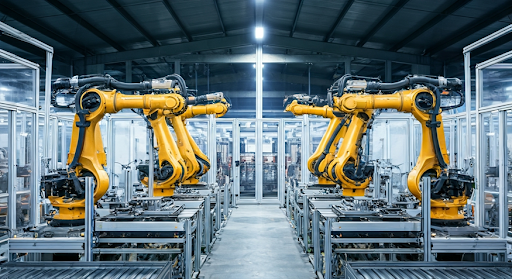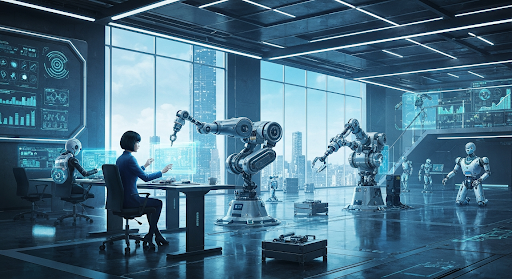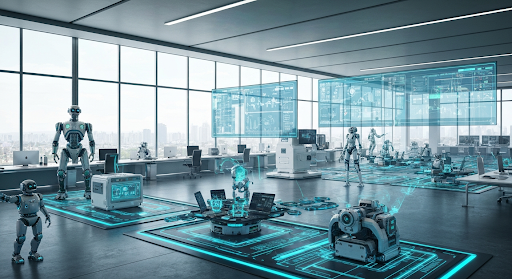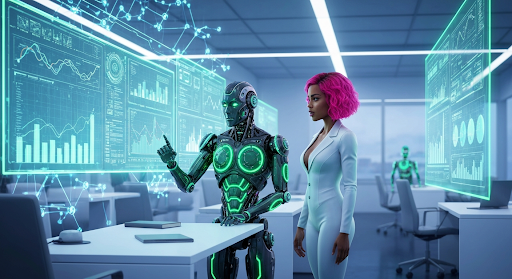Robots Automation: Transforming Industries with Efficiency
Key Highlights
- Robot automation and industrial automation have helped many industries work better, faster, and with more accuracy. This is true in places like manufacturing and healthcare.
- Collaborative robots, also called cobots, are changing the way people and robots work together on the production line or in the warehouse.
- Robotic process automation (RPA) and business process automation help with repetitive tasks. They make these jobs easy, reduce human error, and cut down on running costs.
- Automation technology that uses advanced artificial intelligence and machine learning lets companies do business process automation in smarter ways.
- Intelligent automation and rpa software tools make digital transformation easy to use for all types of organizations, big or small.
- Some key benefits to this are more productivity, cost savings, and better employee satisfaction. But, some common problems are getting the workforce to change and figuring out how to make these changes bigger.
Introduction
The digital transformation of many industries today happens because of automation. Automation software helps take repetitive tasks away from people. Now, many businesses use this new technology to do things like data entry or work on a production line. This change means there is better productivity and most employees can focus on creative or important jobs. When companies use automation for mindless routines, they get more done. This also helps them get ready for new changes in business.
Understanding Robotics and Automation in Industry

Robotics and automation technology are making big changes in factories and other work areas. They help make things move faster and work better. Robotics is about using programmable machines that can be adjusted to do many things. These machines often have sensors and use artificial intelligence. They can do different jobs with little to no help from people. Automation software, on the other hand, handles a wide range of digital and physical jobs. It works with systems that might not involve a robot at all.
In factories and other industries, both robotics and automation are very important. They help each other. Together, they can make operations simple, help cut down on human error, and let businesses change quickly when they need to. Do you want to know what makes robotics and automation different, and how they are each used in the workplace? Let’s look into this more.
Defining Robotics and Its Core Principles
At its core, robotics brings together computer science, engineering, and artificial intelligence to build programmable machines. These machines can do tasks on their own. Robots use advanced technologies like sensors and actuators. With these tools, they can see what is around them and move objects very well. For harder jobs, many robots use artificial intelligence. This helps them make choices and respond in real time to new things in their work area.
Robots are now much more than simple machines. Now, they take care of many repetitive tasks. You see them doing jobs like assembly and welding on factory lines. They are also used in healthcare for complex tasks. The big advantage is that they do tough and repetitive tasks without much human intervention. This makes them a big help in many workplaces.
The main idea behind robotics is autonomy. Some robots do need people to check on them. But many others can work by themselves. They follow their programs and use their control systems to act if something in their space changes. This ability to work alone sets robotics apart from other ways people use machines for automation.
Differentiating Automation from Traditional Robotics
Automation is a broad area that covers many ways to make things work better and faster. The main goal is to do work in a more efficient way. You do not always need a physical robot to use automation. While robotics is a type of automation that uses programmable machines, automation can also mean using hardware, software, or whole systems to do jobs that people usually do.
Automation systems can do both computer-based and real-world tasks, such as:
- Running production lines with little or no action from people
- Using automation software to handle data input and jobs in business
Robotics is a form of automation that looks to copy human intelligence and how people move. On the other hand, automation is not always about copying a person. It can use simple sets of rules, or sometimes, advanced artificial intelligence models that work online or on computers. The main difference is this: robots do things you can see and touch, but automation systems can be something you cannot see and may just live in software programs.
Can you talk about the main differences between robotics and automation and how companies use them? Robotics gives us hardware and lets machines do jobs with more freedom. Automation, on the other hand, can bring big improvements in how things get done, with either hardware or automation software. This lets many businesses do more than they could before, showing the wide range of what automation systems can do when it comes to helping people and companies finish their work, sometimes even without human actions at all.
Evolution of Robots and Automation Technologies

Automation technology started with simple mechanical tools. Over time, it has grown to include smart systems made with machine learning and artificial intelligence. In the early days, key steps in industrial automation helped make the work more steady and increased the amount that people could make. Now, today’s solutions work smoothly in almost any production environment.
With new changes in technology, robots and other automation tools can take on regular and even unpredictable tasks. As electronic components and software get better every year, what we see now is a group of tools that are flexible, smart, and can grow with the work. This shows how people have put in years of hard work to keep making automation technology, artificial intelligence, and machine learning better for everyone.
Milestones in Industrial Automation
Industrial automation has reached remarkable milestones over the past century. From early mechanized looms to today’s AI-powered automation lines, each stage reflects a leap in efficiency and capability.
For a clear summary, see the text table below:
| Milestone | Description |
|---|---|
| Mechanized Looms | First use of machines for repetitive textile tasks without human intervention |
| Programmable Logic Controllers (PLCs) | Enabled automated control of machinery in factories |
| Robotics Introduction | Industrial Robots performed assembly, welding, and painting |
| Computer-Integrated Manufacturing | Connected machines, robotics, and software for cohesive automation |
| AI and Machine Learning | Brought real-time decision-making, computer vision, and adaptive processes |
Each advancement improved the automation process—reducing reliance on human actions and increasing scale and precision. Today, machine learning and intelligent automation further expand these capabilities, allowing seamless integration with modern production lines.
Key Innovations Shaping Modern Robotics
In the past few years, there has been a rise in new ideas in robotics. This has happened because of artificial intelligence, machine learning, and computer vision. AI lets robots handle many types of data and adjust to new things they see. They can also make choices that used to need human intelligence. As Andrew Ng, a well-known researcher in AI, said, “Artificial intelligence is the new electricity.” This big change keeps shaping every industry.
Robots use machine learning to get better with time. They learn from things in the real world to improve what they do. With computer vision, robots can look at what is around them with a very high level of accuracy. This helps with flexible automation in places like warehouses and factories.
These advanced technologies are not just for physical robots. They give power to automation software and RPA bots, too. This makes business process automation smarter and faster. When robotics and intelligent automation come together, they open up new ways of working in many areas.
Types of Robots Used in Industrial Automation
Industrial automation uses different types of robots for different jobs. Each type fits a certain automation process or helps with a special task in production. You can find traditional industrial robots on assembly lines and mobile robots moving around in warehouses. The use of robots helps make work faster, safer, and better organized. They also do some of the hard, boring, or dangerous tasks that need to be done the same way every time, or with very high accuracy.
It is important to know about the many roles that industrial and collaborative robots play. This helps companies pick what is best for their own automation process. Now, let’s look more closely at these types of robots.
Industrial Robots: Roles and Applications
Industrial robots are a key part of most automation lines. They work in production and help things run smoothly. These robots be made to do routine tasks, and they do them fast. They also help a lot to cut down on human error and keep output high.
In practice, industrial robots:
- Handle repetitive assembly, welding, and painting on production lines
- Perform precision material handling and packaging tasks in logistics and warehousing
The robots do well in places where work must be done with speed and accuracy. Many times, they finish jobs without the need for a lot of human intervention. They can even be reprogrammed to do new things when the company needs to change up what they make.
By automating routine tasks, industrial robots let human workers get to more interesting, complex, or creative jobs. This change helps people in the workforce grow and makes many industries, like manufacturing and logistics, work better.
Collaborative Robots (Cobots) vs. Traditional Robots
Collaborative robots, or cobots, are made to work with people and not to take the place of human intelligence. The big difference is that these cobots use advanced technologies like machine learning and computer vision. They work in the same spaces as people and keep everyone safe. Because of this, cobots help lower the chance of human error and take care of many routine tasks. While traditional robots are good for doing the same thing over and over, they cannot adjust as well as cobots do in places where things often change. Cobots help everyone get more done, and they make the workspace friendlier and more efficient.
Robotic Process Automation (RPA) in Business Environments
Streamlining internal processes is one of the big benefits of robotic process automation (RPA) in a business. With the use of software robots, companies can lower human intervention in many repetitive tasks. This boosts how fast things get done and makes operations smoother.
RPA tools work with artificial intelligence and machine learning to handle routine tasks. This cuts down on human error. As a result, you see greater speed and accuracy when processing data in areas like financial services and human resources. All this helps in digital transformation and can lead to better employee satisfaction.
How RPA Works Within Organizations
RPA bots act like people to automate digital work in many parts of a business. These bots use automation software and can work with old legacy systems, user interfaces, and databases just like a person does. This helps everything work well with what a company already uses.
Key aspects of how RPA operates:
- RPA bots get, check, and handle data from many places, like invoices and emails.
- Automation software manages the automation process, so people do less manual work and there is better accuracy.
RPA bots have a simple design that makes them quick to set up. This makes them great for both front-office and back-office jobs. RPA helps fill the gaps between different systems. As a result, RPA bots get rid of slow spots, help transactions go faster, and give support for real-time decisions.
Because of this, companies see better efficiency, cut costs, and see a boost in employee satisfaction as they go through their digital transformation.
Popular Software Platforms for RPA Deployment
Choosing the right RPA software is very important if you want to use robotic process automation in your business. The best RPA tools and software solutions give you powerful intelligent automation. They let you connect with other systems easily. There is a user-friendly design, so both technical and nontechnical people can use them.
Some popular RPA software platforms are:
- UiPath: This one is known for low-code development. It has easy interfaces and strong controls for good management.
- IBM Robotic Process Automation: This gives you powerful process automation with strong security and the option to grow in the future.
These platforms help people in an organization build, test, and manage their automations across many departments. They include valuable features such as process mining, analytics, and AI integration. These make the RPA software even better for your business.
With intelligent automation, companies can do more than simple rule-based tasks. They can take care of complex workflows and work with unstructured data. You should choose an RPA software that works with your own internal processes, meets your security needs, and matches your long-term automation goals.
Benefits and Challenges of Robots Automation
Using automation technology brings big benefits to a business. You can get greater speed, save money, and cut down on human error. This helps companies become more quick and better able to face the competition. With automated workflows, teams get more done in less time. People can use their hours for other important projects. This lets human resources focus on work that matters most.
But there are some problems to solve as well. It can be hard to grow automation, train staff, and fix tech issues. Companies need the right plans and ways to manage these changes. Knowing what the challenges are helps a business get the most out of automation technology. It can also support employee satisfaction and help the business grow.
Efficiency, Cost Savings, and Productivity Gains
Automation helps businesses get more done in less time. Robots and RPA systems can do tasks faster than people, and they work all day and all night without stopping. This means companies do not need as many workers for the same jobs, so the cost goes down.
Key benefits include:
- Less time is needed for boring or simple work. This lets people pay more attention to big goals and plans.
- There are fewer mistakes because automation does the same thing every time. That means less wasted time and money fixing errors.
When you use automation, your team can handle more work with the same group of people. Working faster means better service for customers. Doing things the same way every time helps with quality and following rules.
Automation also helps employee satisfaction. It takes away boring tasks, so people can do work that matters and feel good about what they do. Mixing people’s ideas with the speed of computers is what makes digital transformation work well.
Workforce Impact and Overcoming Implementation Barriers
Automation technology always changes how people work. Some jobs may disappear, but new jobs appear that focus on working with and taking care of automation systems. Also, people often feel better at work, as the boring or hard jobs are replaced with more interesting ones. This helps increase employee satisfaction.
Organizations still may deal with some issues, like:
• Employees might not want to change or worry that their jobs will be lost
• There can be problems when trying to use automation systems with old legacy systems
To handle these issues, open talks are important. It helps to offer regular training and to let human resources and technical teams work together. Teaching people the right skills helps everyone be ready for the change and get the most from automation.
When companies create a space where people want to try new things and can adjust fast, they use automation technology better. This turns problems into new chances to improve business process and to help the business grow.
Real-World Success Stories: Robots and Automation in Action
Robots and automation technology have made things better in many industries. They help the work go faster, lower costs, and bring new ideas to the table. There are many use cases that show automation technology helps companies deliver work more quickly, improve the quality of products, and allow people to spend more time on creative jobs.
These stories show the real and positive effect that robots and intelligent automation bring when they are used in daily business tasks. Now, let’s see how companies have changed their manufacturing work and improved jobs in warehousing and logistics by using intelligent automation solutions.
Transforming Manufacturing Operations
Manufacturing has always been quick to use new and advanced technologies. Automation systems and robots now play a big part in the way things are made. Because of process automation, factories can work at greater speed and be more consistent. With advanced robotics, things like assembly, welding, and moving materials get done with high accuracy.
There are factories that use process automation to handle complex tasks. They connect robots with sensors and use control systems for real-time monitoring. All of this helps work go smoothly. It also cuts down on human error, lowers downtime, and is quick to change when there is more or less demand.
Tom Davenport, who writes for Harvard Business Review, says, “Automation does not replace jobs, it changes them.” Now, instead of doing the same manual task over and over, people watch over robots, fix problems, and help improve processes. This new way of working makes products better, gives people more job satisfaction, and helps businesses grow in the long run.
Enhancing Warehousing and Logistics Efficiency
Warehousing and logistics get many benefits from business process automation and the use of robots. Autonomous mobile robots can pick, sort, and move goods with great accuracy. This helps make fewer mistakes on orders and makes delivery faster.
Automation technology makes it easier to manage inventory by linking RPA bots with warehouse management systems. These bots take care of simple data entry, making labels, and tracking shipments. This lets workers spend more time on harder tasks in logistics.
Flexible automation with collaborative robots helps warehouses change fast when there are more orders or new products. This helps make customers happier and helps everyone use their time and resources well. So, robotics and process automation have a clear, good effect in real-life logistics and business process settings.
Building an Effective Strategy for Adopting Robots Automation
Having a smart automation strategy is very important for success. The businesses need to look at their own internal processes, see if they are ready, and match new technology with what they want to achieve. This helps the automation process bring good value and fit well with what is already there.
A solid plan also has training for people, help with any changes, and ongoing ways to get better. By getting your group ready for digital transformation, you make it possible to have process automation that grows, lasts over time, and helps business process automation lead to long-term success.
Assessing Business Readiness and Needs
Before you start with robots automation, it is important to look at how your business works right now. Use process mining tools to find and fix what does not work well. These tools can show the parts of your work where things get stuck or slow. They also show which parts may be great for automation. This will help you find out if your business is ready for automation and shape your plan.
Key steps for a good start:
- Map out current processes and find all the tasks that you do over and over that follow clear rules
- See if automation technology will work with what you already have
A full check should also look at your team’s tech skills and if they are open to changes. You should also think about what kind of support they will need. Bring your people in from the start to help them get behind the changes, so going live with automation goes more smoothly.
After you know what you need and how ready you are, pick the right automation software. Set clear, real-life goals that you can reach, and plan a way to grow this setup later. Review how things go all the time and make changes if you need to. This helps your company keep up as automation software and business needs change.
Future Trends and Workforce Adaptation
As digital transformation moves faster, new trends in automation are changing the way we work. Cognitive automation uses artificial intelligence and machine learning. It lets robots and rpa bots take on more complex tasks. Now, it can be hard to tell the difference between what people do and what machines do.
Businesses have to get their people ready for this change. They have to spend on ongoing education and training. Workers will need to learn how to manage, program, and improve automation processes. Doing this will not only keep jobs safe but also make employee satisfaction go up.
In the future, when human creativity and the speed of robots come together, there will be new ideas and growth. Companies that go along with these changes will be ready to lead in a tough market. This will help them do well and stay successful for a long time in a world filled with automation.
Conclusion
To sum up, robots and automation are changing how businesses work today. They do more than just change industries. These new technologies are making companies change the way they operate. When you know about how these tools grow and where they can be used, you can make your work faster, lower costs, and get more done. There are lots of ways that using robots—from factories to shipping goods—brings real rewards, but it can bring some problems too. If you want your business to stay ahead and meet what workers will need in the future, it helps to plan carefully how you use automation. If you want to improve how your business works with robots and automation, reach out to us. We can help with a consultation and find solutions that fit your needs.
Frequently Asked Questions
How do robots and automation affect job opportunities?
Automation technology is not only about removing jobs. It changes the way people work and the kind of jobs they have. Some jobs that are very repetitive may no longer be there. But new types of work, like managing, programming, and helping with automation, now come up. This switch can help boost employee satisfaction. It also helps move digital transformation forward in many industries.
What industries are seeing the fastest adoption of robots automation?
Industries that are changing fast because of automation are manufacturing, financial services, warehousing, and healthcare. There is a lot of industrial automation in places where things are made. In the world of financial services, banking, and insurance, process automation and business process automation are helping a lot. These changes help people do their work quicker and with better results across all fields.
Can small businesses benefit from robots automation?
Yes, small businesses can use RPA software and automation tools to save money and make things run better. Automation software helps with business process automation. It makes tasks easier to manage and faster to finish. This kind of technology is not just for big companies. Now, any business can start using process automation to improve the way they work. Business process automation lets businesses of any size use new tools. RPA software can help your business grow and keep things running smooth.
What is Robotics automation?
Robotics automation refers to the use of robots to perform tasks traditionally done by humans, enhancing efficiency and precision. By integrating robotics with software, industries streamline operations, reduce costs, and improve safety. This technology is transforming sectors like manufacturing, logistics, and healthcare, driving innovation and productivity forward.



